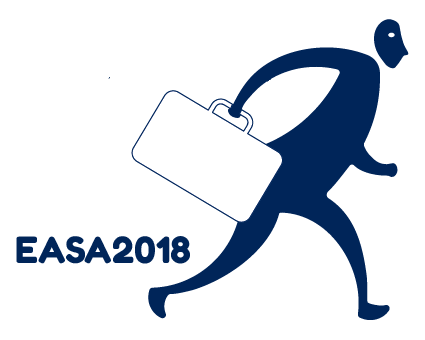15th EASA Biennial Conference
Staying, Moving, Settling
Stockholm University
14-17 August, 2018
Theme: Staying, Moving, Settling
Recent times, for much of humanity but not least in Europe, have been marked by dramatic mobility. It has taken many forms: refugee streams and labour migration, but also pilgrimage, tourism, and the transnational leisure migration of retirees. It is continuously in the news. The varied forms of mobility have also drawn wide imagination for example in literary fiction, and in the movies.
Mobility has also long been a topic in anthropological research. In view of the range and importance of its current forms, mobility is a suitable main theme of the 2018 conference of EASA. We suggest that the conference should not focus narrowly on the forms of spatial movement, but should reflect the variety of its backgrounds, forms and contexts, and longer-term implications. This is mirrored in the conference title.
In many human communities, staying is obviously still the normal way of life, ‘business as usual.’ But often, it is now a matter of choice – remaining, when others are leaving. What are the consequences of staying, perhaps involving changing circumstances of life, loss in personal networks, deteriorating infrastructures, growing vulnerability, perhaps dependence on those who leave (e.g. through remittances)?
The actual acts and processes of moving are multifaceted. They may involve crises, or routines. People may move as individuals or in groups. There may be stations along the way. There may be important factors of infrastructure: airports, small ships, people smugglers, official gatekeepers, host volunteers. Some people reach their intended destinations, others do not. And these acts and processes of moving may draw little or extensive public attention.
And then beyond arrival, there is the drawn-out process of settling – among people who themselves have stayed and are more or less ‘natives,’ and among other newcomers. Relationships to those who may have remained behind need to be reconstructed, in new diaspora networks, and there are all those adaptations which are covered by the term ‘integration’ – in jobs, neighbourhoods, schools and other forms of education, health, care and other welfare institutions, the law. The processes of settling involve not only those who made the move themselves, but often one or more later generations as well.
Possible topics to explore are thus:
Staying
Communities left behind
Receiving countries and communities
Brain drain and brain gain
Migrants and local cultural heritage
Local responses to migrants and refugees: between cosmopolitanism and xenophobia
Dystopias of invasion
Everyday cosmopolitanism
Moving
Refugees
Labour migration
Settler colonialism
Pilgrimage
Migrating retired people – to the sun coasts
Infrastructures of mobility: labour brokerage, smuggling, trafficking
The role of interpreters
Migrants and local journalism
Anthropologists as experts: the public uses of anthropology
Tourism
Travel guides
Student mobility: ERASMUS etc
The mobility of anthropologists: in and out of fields, between jobs
Settling
The meaning of ‘home’
Exiles
Diaporas
Immigrant neighborhoods: the banlieues of Europe
Transnational family and kinship
Settling in: first and second generations, and the relations between them
Mobility and social media
Remittances
Educating and retraining refugees
Refugees, migrants, and job markets
Refugees and migrants in the welfare state
Migrants and the law
Migrants and civil society
Immigrant entrepreneurs
Migrants as agents of world culture: literature, music, cuisine
Official models of diversity/integration: the rise and fall of multiculturalism, Leitkultur etc.







